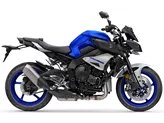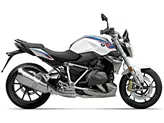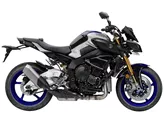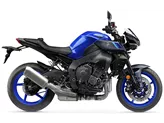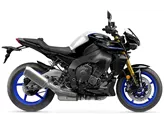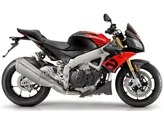Yamaha MT-10 2016 vs. BMW S 1000 R 2016

Yamaha MT-10 2016

BMW S 1000 R 2016
Vue d’ensemble - Yamaha MT-10 2016 vs BMW S 1000 R 2016
The Yamaha MT-10 and the BMW S 1000 R, both released in 2016, are two popular naked bikes in the market. While they share similar engine power and displacement, there are several notable differences between the two models.
In terms of engine and drive train, both bikes feature an in-line 4-cylinder engine with 160 horsepower. The Yamaha MT-10 has a torque of 111 Nm, while the BMW S 1000 R boasts a slightly higher torque of 112 Nm. Both bikes have a displacement of around 1000cc, providing ample power for thrilling rides.
When it comes to suspension, both bikes are equipped with upside-down telescopic forks in the front and a swing arm with a monoshock in the rear. This ensures a smooth and stable ride, allowing riders to handle various road conditions with ease.

Yamaha MT-10 2016
In terms of chassis, the Yamaha MT-10 features an aluminum frame type called Deltabox, which provides excellent rigidity and stability. On the other hand, the BMW S 1000 R has an aluminum frame type called Twin Tube, which also offers good stability but may have a slightly different feel during rides.
Both bikes come with double disk brakes in the front, ensuring powerful and reliable stopping power. Additionally, they both have advanced rider assistance systems such as ABS and traction control, enhancing safety and control during rides.
In terms of dimensions and weights, there are slight differences between the two models. The Yamaha MT-10 has a wheelbase of 1400 mm and a seat height of 825 mm, while the BMW S 1000 R has a slightly longer wheelbase of 1439 mm and a lower seat height of 814 mm. The kerb weight of the Yamaha MT-10 is 210 kg, slightly heavier than the BMW S 1000 R which weighs 207 kg. Both bikes have a fuel tank capacity of around 17 liters.

BMW S 1000 R 2016
Now let's discuss the strengths and weaknesses of each bike. The Yamaha MT-10 is known for its CP4 engine, which gives it a strong character and an unmistakable sound. It is extremely agile and offers high-speed stability. The brakes on the MT-10 are also strong and reliable. However, the MT-10 lacks in terms of comfort, with limited wind protection and a hard fit.
On the other hand, the BMW S 1000 R is praised for its powerful and well-controllable engine, providing a thrilling riding experience. It also boasts a powerful braking system and a comfortable seating position, making it suitable for longer rides. However, the S 1000 R may come with expensive optional extras, which can make it an expensive choice. Additionally, some riders have found the chassis to be on the harder side, which may affect the overall comfort of the bike.
In conclusion, both the Yamaha MT-10 and the BMW S 1000 R offer powerful and thrilling rides with their 160 horsepower engines. While the Yamaha MT-10 excels in agility and high-speed stability, the BMW S 1000 R offers a comfortable seating position and a well-controllable engine. Riders should consider their preferences for comfort, handling, and pricing when choosing between these two models.
Caractéristiques techniques Yamaha MT-10 2016 par rapport à BMW S 1000 R 2016
Avantages et inconvénients en comparaison
Avantages et inconvénients en comparaison
Yamaha MT-10 2016

La MT-10, courte et trapue, est la plus éloignée de la superbike R1, tant au niveau de l'esthétique que du châssis, mais le cœur de la MT-10 est directement issu de l'arme de la piste de course et fascine par sa sonorité brute unique et sa force d'attaque par le bas grâce au décalage typique des tourillons qui, avec une séquence d'allumage modifiée, lui confère ce caractère unique. Les 160 ch qui en résultent ne semblent donc que sur le papier un peu faibles par rapport aux plus de 200 ch de la R1, mais en réalité, la MT-10 déclenche elle aussi un feu d'artifice incroyable. Le châssis serait probablement trop souple pour la piste de course, mais il est tout à fait adapté à un combat sur route et le freinage fait de même - acceptable pour la piste, mais parfait pour la route.
BMW S 1000 R 2016

Sur la BMW S 1000 R, on remarque à la fois la parenté étroite avec la Superbike S 1000 RR et la volonté de doter la machine d'un niveau de confort élevé pour la route et le quotidien. Le moteur quatre cylindres de 1000 cm3 se met donc au travail de manière brutale, tout en restant bien contrôlable, et la position de conduite est par conséquent confortable et sportive. Le fait que la S 1000 R soit l'une des power naked bikes les plus abordables est surprenant et réjouissant, mais il ne faut pas pour autant mettre la main sur la liste des équipements spéciaux - car grâce aux nombreuses caractéristiques irrésistibles, elle sera certainement plus chère.
Comparaison des prix Prix moyen du marché Yamaha MT-10 vs BMW S 1000 R
There are a few key differences between a Yamaha MT-10 2016 and a BMW S 1000 R 2016. In terms of price, the actual average price of a BMW S 1000 R 2016 is about 12% higher. A Yamaha MT-10 2016 experiences a loss of 800 USD in one year and 1,840 USD in two years of ownership. This is offset by a loss of 380 USD and 1,940 USD for a BMW S 1000 R 2016. Compared to BMW S 1000 R 2016 there are less Yamaha MT-10 2016 bikes available on the 1000PS.de Marketplace, specifically 7 compared to 10. It takes less time to sell a BMW S 1000 R with 69 days compared to 97 days for the Yamaha MT-10. Since model year 2016 1000PS.de editors have written 32 reviews for the Yamaha MT-10 and 62 reviews for the BMW S 1000 R since model year 2014. The first review for the Yamaha MT-10 was published on 11/17/2015 and now has more than 20,700 views. This compares to more than 17,300 views for the first review on BMW S 1000 R published on 11/3/2013.



